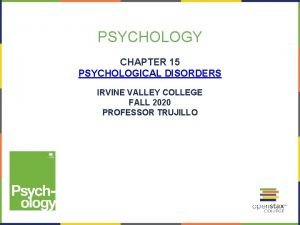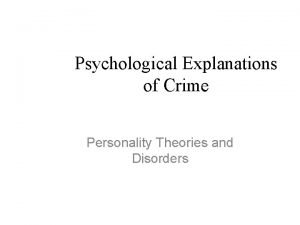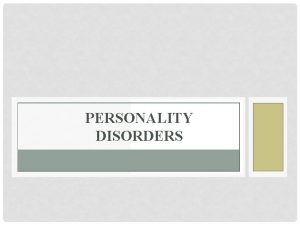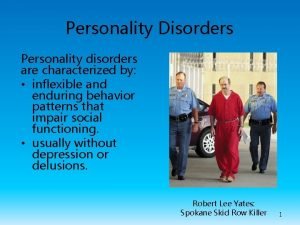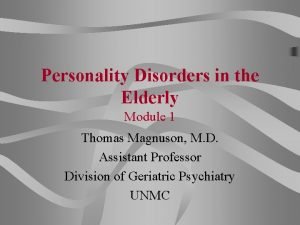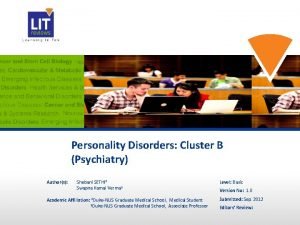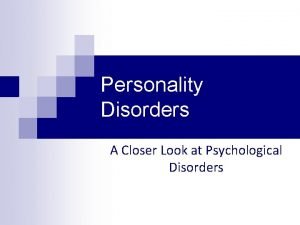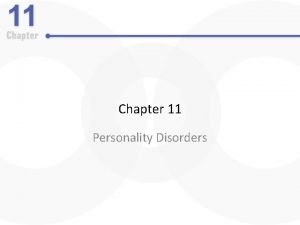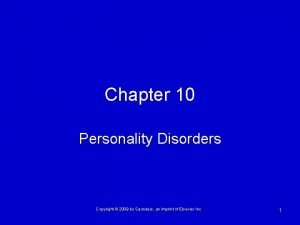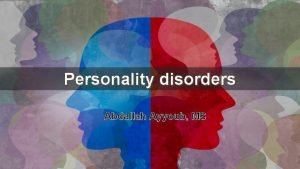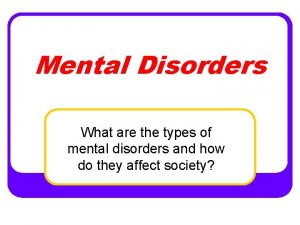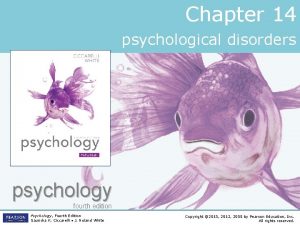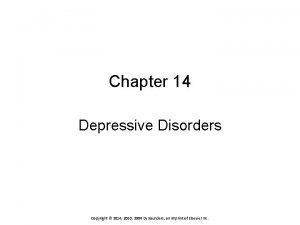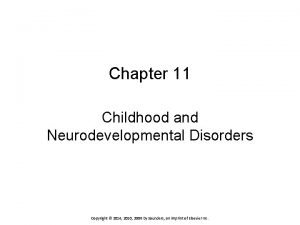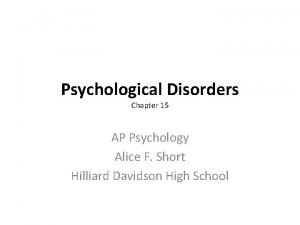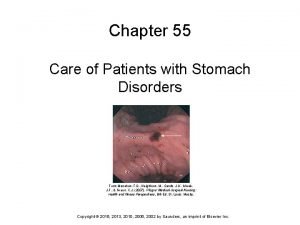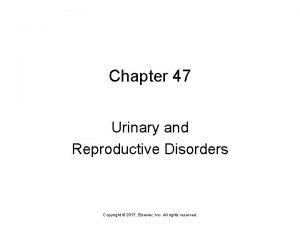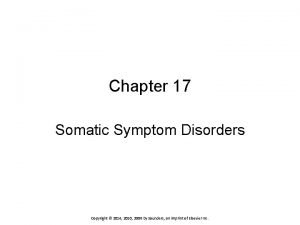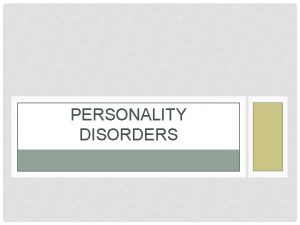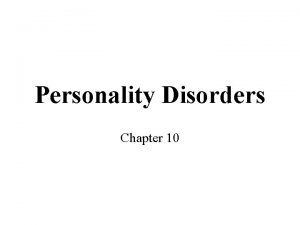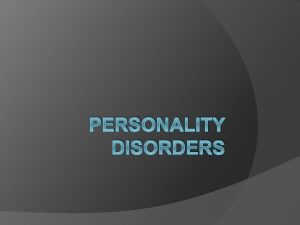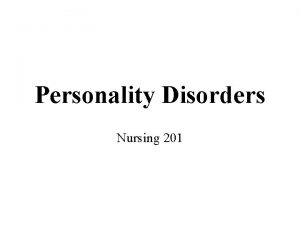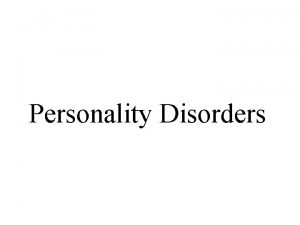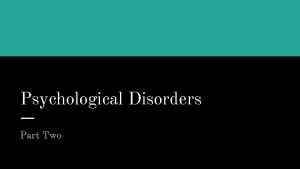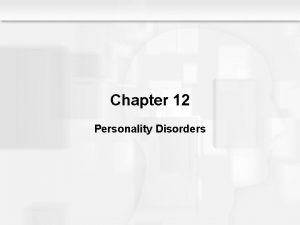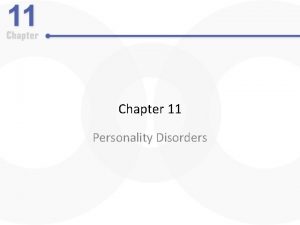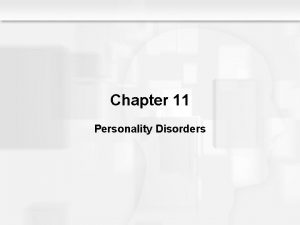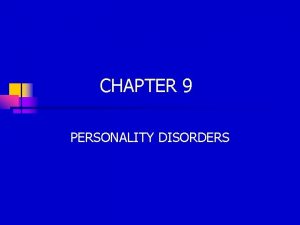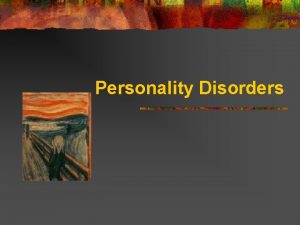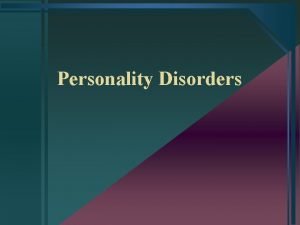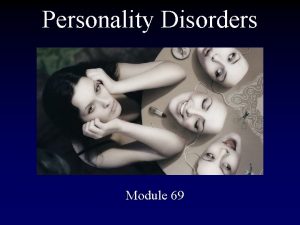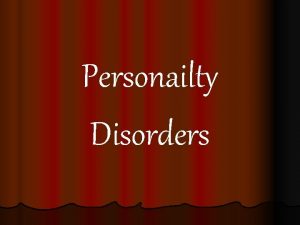Chapter 11 Personality Disorders Definitions People with personality

![Definitions [People with] personality disorders exhibit chronic, pervasive problems getting along with people in Definitions [People with] personality disorders exhibit chronic, pervasive problems getting along with people in](https://slidetodoc.com/presentation_image_h/8e13c0caebd64407494e9c07829e5712/image-2.jpg)











































- Slides: 45

Chapter 11 Personality Disorders
![Definitions People with personality disorders exhibit chronic pervasive problems getting along with people in Definitions [People with] personality disorders exhibit chronic, pervasive problems getting along with people in](https://slidetodoc.com/presentation_image_h/8e13c0caebd64407494e9c07829e5712/image-2.jpg)
Definitions [People with] personality disorders exhibit chronic, pervasive problems getting along with people in all kinds of different contexts, and this includes therapists. T. Lynch, Duke University, 2004. People with PD tend to show little behavioral flexibility. For example, if someone with a PD attempts to make friends and fails, he might decide his well-being depends on avoiding all human contact in the future. Most do not try new behaviors but repeat maladaptive ones. Art Freeman, 2004

Personality Disorders Other researchers are investigating genetic links to aggression, anxiety, and fear – traits that could be influential in the later development of personality disorders APA Monitor, March 2004

For some disorders, such as Antisocial PD, the evidence suggests that genetic factors play a significant role, while others, such as Dependant PD, appear to be more environmentally influences. Theodore Millon Ph. D.

. . . found an association between the severity of specific PD and the type of childhood trauma. In particular, people with Borderline PD reported particularly high rates of childhood sexual trauma – 55% detailing physically forced, unwanted sexual contact. T. Shea, 2002

Personality Disorders: An Overview • The Nature of Personality Disorders – Enduring and relatively stable predispositions (i. e. , ways of relating and thinking) – Predispositions are inflexible and maladaptive, causing distress and/or impairment – Coded on Axis II of the DSM-IV and DSM-IV-TR • Categorical vs. Dimensional Views of Personality Disorders • DSM-IV and DSM-IV-TR Personality Disorder Clusters – Cluster A – Odd or eccentric cluster (e. g. , paranoid, schizoid) – Cluster B – Dramatic, emotional, erratic cluster (e. g. , antisocial, borderline) – Cluster C – Fearful or anxious cluster (e. g. , avoidant, obsessivecompulsive)

Personality Disorders: Facts and Statistics • Prevalence of Personality Disorders – Affect about 0. 5% to 2. 5% of the general population – Rates are higher in inpatient and outpatient settings • Origins and Course of Personality Disorders – Thought to begin in childhood – Tend to run a chronic course if untreated • Co-Morbidity Rates are High • Gender Distribution and Gender Bias in Diagnosis – Gender bias exists in the diagnosis of personality disorders – Such bias may be a result of criterion and/or assessment gender bias

Cluster A: Paranoid Personality Disorder • Overview and Clinical Features – Pervasive and unjustified mistrust and suspicion • The Causes – Biological and psychological contributions are unclear – May result from early learning that people and the world is a dangerous place • Treatment Options – Few seek professional help on their own – Treatment focuses on development of trust – Cognitive therapy to counter negativistic thinking – Lack good outcome studies showing that treatment is efficacious

Mnemonic for Paranoid PD • • S - spouse is cheating suspected U - unforgiving - bears grudges S - suspicious (of others) P - perceives attacks (and reacts quickly) E - enemy in everyone - suspects associates, friends C - confiding in others feared T - threats seen in very benign events Pinkofsky HB. Mnemonics for DSM-IV personality disorders. Psychiatr Serv. 1997 Sep; 48(9): 1197 -8.

Fatal Attractions Many PDs tend to marry each other but at the opposite ends of the spectrum. Examples: Obsessive-compulsive marry histrionic types. Narcissistic marry dependant types. If they get divorced, they tend to marry the same type again. Kaslow, 2004

Up to 30% of people who require mental health services has at least one personality disorder (PD) – characterized by abnormal and maladaptive inner experience and behavior While people with PDs can possess very different personality disturbances, they have at least one thing in common: chances are their mental illness will not remit without professional intervention. People with PD do not often seek treatment and those who do often drop out. The drop-out rate from treatment for Borderlines is 70%

Cluster A: Schizoid Personality Disorder • Overview and Clinical Features – Pervasive pattern of detachment from social relationships – Very limited range of emotions in interpersonal situations • The Causes – Etiology is unclear – Preference for social isolation in schizoid personality resembles autism • Treatment Options – Few seek professional help on their own – Focus on the value of interpersonal relationships, empathy, and social skills – Treatment prognosis is generally poor – Lack good outcome studies showing that treatment is efficacious

Mnemonic for Schizoid PD • • S – shows emotional coldness O – omits close relationships L – lacks close friends or confidants I – involved in solitary activities T – takes pleasure in few activities A – appears indifferent to praise or criticism R – restricted interest in sexual experiences Y – yanks himself from social relationships

Cluster A: Schizotypal Personality Disorder • Overview and Clinical Features – Behavior and dress is odd and unusual – Most are socially isolated and may be highly suspicious of others – Magical thinking, ideas of reference, and illusions are common – Risk for developing schizophrenia is high in this group • The Causes – Schizoid personality – A phenotype of a schizophrenia genotype? – Left hemisphere and more generalized brain deficits • Treatment Options – Main focus is on developing social skills – Treatment also addresses comorbid depression – Medical treatment is similar to that used for schizophrenia – Treatment prognosis is generally poor

Mnemonic for Schizotypal PD • • • M - magical thinking that influences behavior, superstitiousness or the paranormal E - eccentric behavior or appearance P - paranoid ideation E - experiences unusual perceptions C - constricted affect U - unusual thinking & speech L - lacks friends I - ideas of reference A - anxiety (socially) R - rule out psychotic disorders & pervasive developmental disorder

Cluster B: Antisocial Personality Disorder • Overview and Clinical Features – Failure to comply with social norms and violation of the rights of others – Irresponsible, impulsive, and deceitful – Lack a conscience, empathy, and remorse • Relation Between Psychopathy and Antisocial Personality Disorder • Relation Between ASPD, Conduct Disorder, and Early Behavior Problems – Many have early histories of behavioral problems, including conduct disorder – Many come from families with inconsistent parental discipline and support – Families often have histories of criminal and violent behavior

Overlap and lack of overlap among antisocial personality disorder, psychopathy, and criminality Figure 11. 2

Lifetime course of criminal behavior in psychopaths and nonpsychopaths Figure 11. 3

Mnemonic for Antisocial PD • • C - cannot follow law O - obligations ignored R - remorselessness R - recklessness U - underhandedness P - planning deficit T - temper

Neurobiological Contributions and Treatment of Antisocial Personality • Prevailing Neurobiological Theories – Underarousal hypothesis – Cortical arousal is too low – Cortical immaturity hypothesis – Cerebral cortex is not fully developed – Fearlessness hypothesis – Psychopaths fail to respond with fear to danger cues – Gray’s model of behavioral inhibition and activation • Treatment – Few seek treatment on their own – Antisocial behavior is predictive of poor prognosis, even in children – Emphasis is placed on prevention and rehabilitation – Often incarceration is the only viable alternative

Cluster B: Borderline Personality Disorder • Overview and Clinical Features – Patterns of unstable moods and relationships – Impulsivity, fear of abandonment, coupled with a very poor selfimage – Self-mutilation and suicidal gestures are common – Most common personality disorder in psychiatric settings – Comorbidity rates are high • The Causes – Borderline personality disorder runs in families – Early trauma and abuse seem to play some etiologic role • Treatment Options – Few good treatment outcome studies – Antidepressant medications provide some short-term relief – Dialectical behavior therapy is the most promising psychosocial approach

Mnemonic for Borderline PD • • • P - Paranoid ideas R - Relationship instability A - Angry outbursts, affective instability, abandonment fears I - Impulsive behavior, identity disturbance S - Suicidal behavior E - Emptiness

Cluster B: Histrionic Personality Disorder • Overview and Clinical Features – Patterns of behavior that are overly dramatic, sensational, and sexually provocative – Often impulsive and need to be the center of attention – Thinking and emotions are perceived as shallow – Common diagnosis in females • The Causes – Etiology is largely unknown – Is histrionic personality a sex-typed variant of antisocial personality? • Treatment Options – Few good treatment outcome studies – Treatment focuses on attention seeking and long-term negative consequences – Targets may also include problematic interpersonal behaviors – Little evidence that treatment is effective

Mnemonic for Histrionic PD • • • P - provocative (or seductive) behavior R - relationships, considered more intimate than they are A - attention, must be at center of I - influenced easily S - speech (style) - wants to impress, lacks detail E - emotional lability, shallowness • • M - make-up - physical appearance used to draw attention to self E - exaggerated emotions - theatrical

Cluster B: Narcissistic Personality Disorder • Overview and Clinical Features – Exaggerated and unreasonable sense of self-importance – Preoccupation with receiving attention – Lack sensitivity and compassion for other people – Highly sensitive to criticism – Tend to be envious and arrogant • The Causes – Link with early failure to learn empathy as a child – Sociological view – Narcissism as a product of the “me” generation • Treatment Options – Extremely limited treatment research – Treatment focuses on grandiosity, lack of empathy, unrealistic thinking – Treatment may also address co-occurring depression – Little evidence that treatment is effective

Cluster C: Avoidant Personality Disorder • Overview and Clinical Features – Extreme sensitivity to the opinions of others – Highly avoidant of most interpersonal relationships – Are interpersonally anxious and fearful of rejection • The Causes – Numerous factors have been proposed – Early development – A difficult temperament produces early rejection • Treatment Options – Several well-controlled treatment outcome studies exist – Treatment is similar to that used for social phobia – Treatment targets include social skills and anxiety

Mnemonic for Avoidant Personality • • A – Avoids occupational activities V – Views self as socially inept O – Occupied with being criticized or rejected I – Inhibited in new interpersonal situations D – Declines to get involved with people E – Embarrassed by engaging in new activities R – Restrains from intimate relationships

Cluster C: Dependent Personality Disorder • Overview and Clinical Features – Excessive reliance on others to make major and minor life decisions – Unreasonable fear of abandonment – Tendency to be clingy and submissive in interpersonal relationships • The Causes – Still largely unclear – Linked to early disruptions in learning independence • Treatment Options – Research on treatment efficacy is lacking – Therapy typically progresses gradually – Treatment targets include skills that foster independence

Mnemonic for Dependent PD • • • D – Difficulty making everyday decisions E – Excessive lengths to obtain nurturance and support from others P – Preoccupied with fears of being left to take care E – Exaggerated fears of being unable to care for himself or herself N – Needs others to assume responsibility for his or her life D – Difficulty expressing disagreement with others E – End of a close relationship is the beginning of another relationship N – Noticeable difficulties in initiating projects or doing things on his or her own T – “Take care of me” is his or her motto

Cluster C: Obsessive-Compulsive Personality Disorder • Overview and Clinical Features – Excessive and rigid fixation on doing things the right way – Tend to be highly perfectionistic, orderly, and emotionally shallow – Obsessions and compulsions, as in OCD, are rare • The Causes – Are largely unknown • Treatment Options – Data supporting treatment are limited – Treatment may address fears related to the need for orderliness – Other targets include rumination, procrastination, and feelings of inadequacy

Summary of Personality Disorders • Personality Disorders – Long-standing, ingrained ways of thinking, feeling, and behaving • Disagreement Exists Over How to Categorize Personality Disorders – Categorical vs. dimensional, or some combination of both • DSM-IV and DSM-IV-TR Includes 10 Personality Disorder – Personality disorders fall in one of three clusters – Cluster A, B, or C • The Causes of Personality Disorders Are Difficult to Pinpoint • Treatment of Personality Disorders Is Often Difficult

DSM-IV Personality Disorders Under Study • • Proposed DSM Personality Disorders – Sadistic personality disorder – Self-defeating personality disorder New Categories of DSM Personality Disorders Under Study – Depressive personality disorder – Negativistic personality disorder

Treatment Issues • Resilience helps to buffer people from negative experiences. • “People with PD have so little resilience, it makes it especially important to deal with [this deficit] » Freeman, 2004

Treatment Issues “helping individuals with PD to develop cognitive, behavioral, social and emotional competencies will assist them to manage day-to-day stressors and events effectively. ” Reinecke, 2004

Treatment Issues A caring outside adult, teacher, or caregiver can off-set negative influences of a dysfunctional parent or environment. It is a fit between your personality and your environment.

Treatment • • Dialect Behavior Therapy is a promising approach combining both cognitive behavior therapy and behavior therapy in treating certain PD. Borderline is the primary focus of these treatment efforts.

Summary of Personality Disorders (cont. ) Figure 12. x 1 Exploring personality disorders, cluster a

Summary of Personality Disorders (cont. ) Figure 12. x 1 (cont. ) Exploring personality disorders, cluster a

Summary of Personality Disorders (cont. ) Figure 12. x 1 (cont. ) Exploring personality disorders, cluster a

Summary of Personality Disorders (cont. ) Figure 12. x 1 (cont. ) Exploring personality disorders, cluster a

Summary of Personality Disorders (cont. ) Figure 12. x 2 Exploring personality disorders, cluster b

Summary of Personality Disorders (cont. ) Figure 12. x 2 (cont. ) Exploring personality disorders, cluster b

Summary of Personality Disorders (cont. ) Figure 12. x 3 Exploring personality disorders, cluster c

Summary of Personality Disorders (cont. ) Figure 12. x 3 (cont. ) Exploring personality disorders, cluster c

Summary of Personality Disorders (cont. ) Figure 12. x 3 (cont. ) Exploring personality disorders, cluster c
 What are the 10 personality disorders
What are the 10 personality disorders Cluster c
Cluster c Avoidant personality traits
Avoidant personality traits Personality disorders dsm 5
Personality disorders dsm 5 Group c personality disorders
Group c personality disorders Cluster c
Cluster c Cluster b personality disorder
Cluster b personality disorder Anankastic personality disorder
Anankastic personality disorder Karla homulka
Karla homulka Cluster b personality disorder
Cluster b personality disorder Antisocial personality disorder mnemonic
Antisocial personality disorder mnemonic Cluster b personality disorders
Cluster b personality disorders Weird wild wacky personality disorders
Weird wild wacky personality disorders Type c personality disorder
Type c personality disorder Personality disorder types
Personality disorder types Chapter 19 matching words with definitions
Chapter 19 matching words with definitions Sentence check 1 chapter 13
Sentence check 1 chapter 13 Chapter 18 psychological disorders review worksheet
Chapter 18 psychological disorders review worksheet Chapter 11 genetic disorders concept mapping
Chapter 11 genetic disorders concept mapping Chapter 8 skin disorders and diseases review questions
Chapter 8 skin disorders and diseases review questions Chapter 6 musculoskeletal system
Chapter 6 musculoskeletal system Chapter 46 digestive and endocrine disorders
Chapter 46 digestive and endocrine disorders Types of somatic disorder
Types of somatic disorder Chapter 29 endocrine and metabolic disorders
Chapter 29 endocrine and metabolic disorders Chapter 21 mental health diseases and disorders
Chapter 21 mental health diseases and disorders Chapter 18 psychological disorders
Chapter 18 psychological disorders Chapter 18 eating and feeding disorders
Chapter 18 eating and feeding disorders Chapter 17 reproductive system diseases and disorders
Chapter 17 reproductive system diseases and disorders Chapter 15 nervous system diseases and disorders
Chapter 15 nervous system diseases and disorders Chapter 15 anxiety and obsessive-compulsive disorders
Chapter 15 anxiety and obsessive-compulsive disorders Chapter 14 psychological disorders
Chapter 14 psychological disorders Chapter 14 depressive disorders
Chapter 14 depressive disorders Chapter 11 childhood and neurodevelopmental disorders
Chapter 11 childhood and neurodevelopmental disorders Chapter 5 glencoe health answers
Chapter 5 glencoe health answers Seborrheic keratoses
Seborrheic keratoses Chapter 5 mental and emotional problems answer key
Chapter 5 mental and emotional problems answer key In what situation should a nail service be performed
In what situation should a nail service be performed Milady chapter 10
Milady chapter 10 Cardiovascular system diseases and disorders chapter 8
Cardiovascular system diseases and disorders chapter 8 Milady chapter 8 skin disorders and diseases
Milady chapter 8 skin disorders and diseases Chapter 14 psychological disorders
Chapter 14 psychological disorders Ap psychology chapter 15
Ap psychology chapter 15 Chapter 55 care of patients with stomach disorders
Chapter 55 care of patients with stomach disorders Chapter 47 urinary and reproductive disorders
Chapter 47 urinary and reproductive disorders Chapter 17 somatic symptom disorders
Chapter 17 somatic symptom disorders Chapter 12 schizophrenia spectrum disorders
Chapter 12 schizophrenia spectrum disorders
